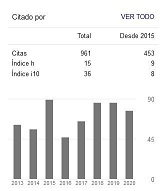Multipurpose Autochthonous Microorganisms to treat Neonatal Swine Colibacillosis.
Resumen
The effectiveness of multipurpose autochthonous microorganisms was evaluated as a therapeutical alternative in Yorkshire pigs with neonatal colibacillosis. Morbidity and mortality data from Camujiro Special Swine Center, Ca-magüey, Cuba were processed in the June-July, 2012 period; most animals (89.8 %) recovered after the therapy.Descargas
Citas
AQUILINA, G.; BAMPIDIS, V.; BASTOS, M.; GUIDO, L.; FLACHOWSKY, G.; GRALAK, M. et al. (2014). Scientific Opinion on the Safety and Efficacy of Yea-Sacc® (Saccharomyces cerevisiae) as a Feed Additive for Cattle for Fattening, Goats for Fattening, Dairy Cows, Dairy Sheep, Dairy Goats and Buffaloes. EFSA Journal, 12 (5), 3666-3681.
BARRETO, G. (2007). Escherichia coli, últimos 122 años (article in review). Rev. prod. anim. 19 (spe-cial issue), 55-67.
BOIRIVANTA, M. y STROBER. W. (2007). The Mechanism of Action of Probiotics. Immunology, 23, 679-692.
BUNNER C. A.; NORBY, B.; BARTLETT, P. C.; ERSKINE, R. J.; DOWNES, F. P.; KANEENE, J. B. (2007). Pre-valence and Pattern of Antimicrobial Susceptibility in Escherichia coli Isolated from Pigs Reared under Antimicrobial-Free and Conventional Production Methods. J. Am. Vet. Med. Assoc., 231, (2), 275-83.
CAMPAL, A. (2009). Panel de anticuerpos monoclonales antifimbrias como herramienta para la detección de Escherichia coli enterotoxigénicas en porcinos. PhD Thesis in Veterinarian Medicine, CENSA, Havana, Cuba.
CORCIONIVOSCHI, N.; DRINCEANU, D.; STEF, L.; LUCA, I.; JULEAN, C. y MINGYART, O. (2010). Pro-biotics-Identification and Ways of Action. Innova-tive Romanian Food Biotechnology, 6, 1-11.
CORR, S. C. (2007). Bacteriocin Production as a Mechanism for the Antiinfective Activity of Lactoba-cillus salivarius UCC118. Proc. Natl. Acad. Sci., 104, 7617-7621.
COX, E. (2011). Colibacillosis in Swine. Reviewed at Lesaffre Symposium, Lille, France, November 8-9. Retrieved on May 15, 2015, from http://www.colibacillosis_in_swine_reviewed_at_Lesaffre_symposium.html.
DELGADO, R. (2014). Efecto probiótico de Saccharo-myces cerevisiae en la ganancia de peso y salud de terneros en pastoreo. Master´s Thesis on Sustaina-ble Animal Production, Faculty of Agricultural Sciences, University of Camaguey, Cuba.
LIÉVIN, V.; PEIFFER, I.; HUDAULT, S.; ROCHAT, F.; BRASSART, D.; NEESER, J. R. et al. (2000). Bifido-bacterium Strains from Resident Infant Human Ga-strointestinal Microflora Exert Antimicrobial Ac-tivity. Gut., 47, 646-652.
MACÍAS, M.; DOMÍNGUEZ, P. L.; ABELEDO, C. M.; SOSA, R.; GARCÍA, A.; CRUZ, E. et al. (2015). Manual de procedimientos tecnicos para la crianza porcina. La Habana, Cuba: EDIPORC-Institute for Swine Research.
MEGANCK, V.; HOFLACK, G. y OPSOMER, G. (2014). Advances in Prevention and Therapy of Neonatal Dairy Calf Diarrhoea: a Systematical Review with Emphasis on Colostrum Management and Fluid Therapy. Acta Vet Scand., 56 (1), 75.
MORRISON, D. J.; MACKAY, W. G.; EDWARDS, C. A.; PRESTON, T.; DODSON, B.; WEAVER, L. T. (2006). Butyrate Production from Oligofructose Fermenta-tion by the Human Faecal Flora: What is the Co n-tribution of Extracellular Acetate and Lactate? Br. J. Nutr., 96, 570-577.
RODRÍGUEZ, H.; BARRETO, G.; BERTOT, J. y VÁZQUEZ, R. (2013). Microorganismos eficientes como pro-motores del crecimiento en cerdos hasta el destete. REDVET, 14 (9). Retrieved on May 15, 2015, from http://www.veterinaria.org/revistas/redvet/n090913.html.
WINDEYER, M. C.; LESLIE, K. E.; GODDEN, S. M.; HODGINS, D. C.; LISSEMORE, K. D. y LEBLANC, S. J. (2014). Factors Associated with Morbidity, Mor-tality, and Growth of Dairy Heifer Calves up to 3 Months of Age. Prev Vet Med., 113, 231-240.
ZAKARIA, Z.; GAIROLA, S. y MOHD, S. (2010). Effective Microorganisms (EM) Technology for Water Quality Restoration and Potential for Sustainable Water Resources and Management. International Congress on Environmental Modelling and Soft-ware Modelling for Environment’s Sake, Fifth Biennial Meeting, Ottawa, Canadá. Retrieved on May 15, 2015, from http://www.sandrelli.net/Effective%20microorganisms.pdf.
Los autores de los artículos publicados en RPA retienen los derechos de autor de su trabajo, de marca y patente, y también sobre cualquier proceso o procedimiento descrito en el artículo, así como a compartir, copiar, distribuir, ejecutar y comunicar públicamente el artículo publicado en la RPA o cualquier parte de aquel siempre que indiquen la fuente de publicación (autores del trabajo, revista, volumen, número y fecha), pero están de acuerdo en que la revista publique los trabajos bajo una licencia Creative Commons.
![]() Licencia Attribution-NonCommercial 4.0 International (CC BY-NC 4.0)
Licencia Attribution-NonCommercial 4.0 International (CC BY-NC 4.0)






































